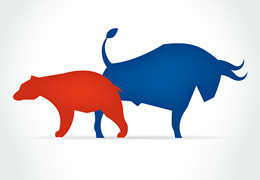
The stock markets have originated a near-infinite number of colloquial expressions, used to describe in a simple their actors and inner-workings. Here we compile some of Wall Street's best animalistic references.
11 february 2016
«Is 2016 the year of the bear?», «Beware the dead cat bounce!»… Animalistic metaphors are frequently used by the financial press. Here we compile some of the most prominent zoological references of the economical jargon, along with those that lost their way between Wall Street and the Spanish markets.
«Bear market» and «Bull market»
Possibly the most feared animal at the start of this year has been the bear. What we know in Spanish as a “downward” market is known in English as a «Bear market»: an extended descent in the stock market (over two months), for more than 20% of the stock’s highest value (in that time period). If it’s down from 10% to 20% the term “correction” is more commonly used, though that can lead to certain confusions (such as this S&P example).
On the other side, a «bull market» means exactly the opposite, an upward trend in market valuation.
While the origin of these terms is not clear, there are several theories:
- The most common explanation: bulls attack/charge with their horns in an upward movement; while bears hunt striking with their claws in a descending fashion.
- The term «bear» may find its root in the bearskin sale. Mediators sold the fur – then in high demand – before actually receiving them, expecting prices to drop in the space of time before they would buy it off the hunters, thus making a profit. An example of short-selling that, of course, could also go wrong (“Don’t sell the bear’s skin before hunting it”). The term “bearskin jobber” later became commonplace at the stock market, defining this type of investor.
- The Germanic etymological origin of the word bull is “bhel-“, which could be translated as “blow, inflate, swell”.
«The dead cat bounce»
A metaphor as brute as it is effective at illustrating the phenomenon it describes. A set of shares, businesses, indexes, is on a downward trend. Suddenly, its value spikes on the stock market before, in the following days, return to a bearish spiral. Beware earnings when they come against the tide.
Unicorns
They used to be unimaginable, as much a part of mythology as the “animal” that represents them. But now so many of them exist, there are fears that their own bubble is building. “Unicorn” businesses are start-ups, generally less than five-years old (yet not a requirement), valued at over a billion dollars without a stock market record. Uber, Dropbox and before them Facebook… These companies generate on average 26$ for every 1$ of private investment.
Similarly, “dragons” are businesses with the same features that generate a return of 100% or more on a fund’s investments.
Sheep
Investors that, as their name describes, follow the bleating of the herd. They invest based on their emotions, suggestions, with no strategy. While bears and bulls focus all movements according to how they expect the market to move, “sheep” move blindly. Mostly used in English.
«Black Swan»
The term can be traced back to novelist and statistician Nassim Nicholas Taleb and his book of the same name, and basically explains an unexpected, impossible to predict event, even with the most complex investment models.
And many tigers…
These term has been repeated over and over again in reference to countries (or eras) with a marked and prolonged growth period. The Celtic Tiger (Ireland from the nineties until the recent crisis), the Nordic Tiger (Iceland, following the privatization of its banking sector until 2008), or even the Four Asian Tigers (sometimes called Dragons) – post-WWII South Korea, Taiwan, Hong Kong and Singapore – are some examples.











